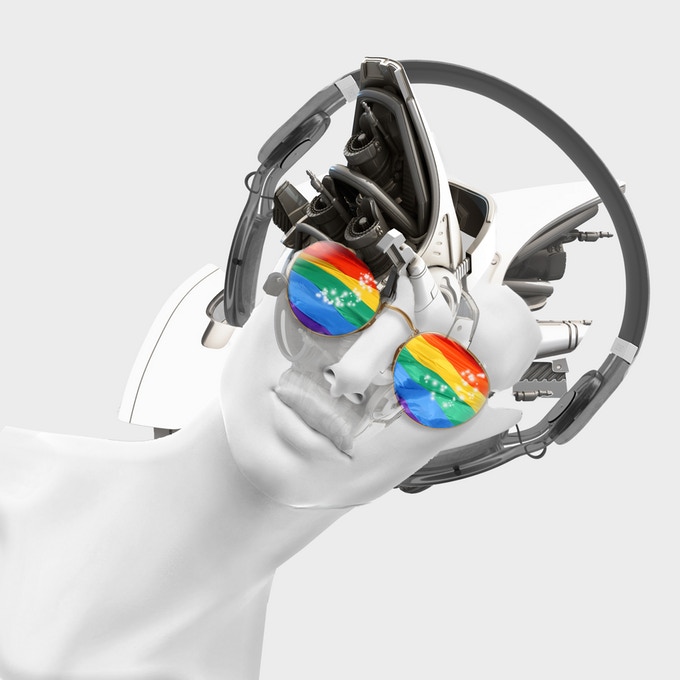
LGBTQI2+ PERSONS & DIGITAL CULTURES
The web has been a source of both liberation and increased harassment for people identifying with non-conformist sexualities and genders. On the positive side, the anonymity of the web has provided a safe space for people to explore alternative sexualities and connect with others dealing with the pleasures and dangers of non-mainstream sexual identities. In many cases, these connections have been literally life-saving.
On the other side, that same anonymity has been fertile ground for homophobic and heteronormative ranting, raving and harassment. And, as with other categories of stigmatized or marginalized social identities, representations of LGBTQI2+ folks in various digital media are often stereotypical and denigrating.

Artwork by Elizabeth Leggett
Sexual and gender identities are never isolated social markers. They are always interwoven with class, race, ethnicity and a variety of other factors, and most of the materials in this section acknowledge such intersectionality.
Sources below include analyses of these issues, and links to organizations working to the make digital spaces (and non-digital ones) more user-friendly to LGBTQI2+ communities.
Books and Articles on LGBTQI2+ Communities Digital Spaces
Alexander, Jonathan. ed. "Queer Webs: Representations of LGBT People and Communities on the World Wide Web." Intro to a special issue of International Journal of Sexuality and Gender Studies 7(2/3) (2002): 77-84.
Brouwer, Daniel. “Making Sense of 'God Hates Fags' and 'Thank God for 9 11': A Thematic Analysis of Milbloggers' Responses to Reverend Fred Phelps and the Westboro Baptist Church.” Western Journal of Communication 71.1 (2007): 69-90.
Burke, Susan. “In Search of Lesbian Community in an Electronic World.” CyberPsychology and Behavior, 3(4) (2000): 591-604
Campbell, John Edward. Getting It on Online: Cyberspace, Gay Male Sexuality, and Embodied Identity. Routledge, 2004.
---. “Outing PlanetOut: Surveillance, Gay Marketing and Internet Affinity Portals.” New Media & Society 7.5 (2005): 663-683.
Carstensen, Tanja. Gender Trouble in Web 2.0: Gender Relations in Social Network Sites, Wikis and Weblogs GST 1.1. (2009).
Ferreday, Debra. "Computer Cross-dressing: Queering the Virtual Subject," in O'Riordan, ed. Queer Online, 155-74.
Friedman, Elisabeth. “Lesbians in (Cyber)Space: The Politics of the Internet in Latin American On- and Off-Line Communities.” Media, Culture & Society 29.5 (2007): 790-811.
Franco, Judith. "Langsters Online: kd lang and the Creation of Internet Fan Communities." In Su Holmes, and Sean Redmond, eds. Framing Celebrity: New Directions in Celebrity Culture. London: Routledge, 2006:269-284.
Foster, Thomas. "'Trapped by the Body'? Telepresence Technologies and Transgendered Performance in Feminist and Lesbian Rewritings of Cyberpunk Fiction." In David Bell and Barbara M. Kennedy. eds, Cybercultures Reader. NY: Routledge, 2002: 439-460.
Gaboury, Jacob. "A Queer History of Computting." Rhizome, Feb 19, 2013.
Gay, Lesbian and Straight Education Network. Out Online: The Experiences of Lesbian, Gay, Bisexual and Transgender Youth on the Internet. Results of an extensive 2013 survey.
Gosine, Andil. "Brown to Blonde at Gay.Com: Passing White in Queer Cyberspace," in O'Riordan, ed. Queer Online, 139-54.
Gray, Mary L. Out in the Country: Youth, Media, and Queer Visibility in Rural America. New York University Press, 2009.
Heinz, B. et. al. "Under the Rainbow Flag: Webbing Global Gay Identities." International Journal of Sexuality and Gender Studies 7(2/3) (2002): 107-24.
Jung, Susanne. Queering Popular Culture:Female Spectators and the Appeal of Writing Slash Fiction. Gender Forum (2004).
Laukkanen, Marjo. "Young Queers Online: The Limits and Possibilities of Non-Heterosexual Self-Representation in Online Conversations," in O'Riordan, ed. Queer Online, 81-100.
Mitra, Rahul. “Queer Blogging in Indian Digital Diasporas.” Journal of Communication Inquiry 32.4 (2008): 400-423.
Nip, Joyce Y.M. "The Relationship between Online and Offline Communities: The Case of the Queer Sisters." Media, Culture & Society, Vol. 26, No. 3, 409-428 (2004).
O'Riordan, Kate. "Queer Theories and Cybersubjects," in O'Riordan, ed. Queer Online, 13-30.
O'Riordan, Kate and David Phillips, eds. Queer Online: Media Technology and Sexuality. Peter Lang, 2007.
Rak, J. "Digital Queer: Weblogs and Internet Identity." Biography 28(1) (2005): 166-182.
Shaw, Adrienne. "Putting the Gay in Games: Cultural Production and GLBT Content in Video Games." Games and Culture, 4.3 (2009): 228-253.
Tsang, Daniel. "Notes on Queer 'n' Asian Virtual Sex." In David Bell and Barbara M. Kennedy. eds, Cybercultures Reader. NY: Routledge, 2002: 432-438.
Wakeford, Nina. "Cyberqueer." In David Bell and Barbara M. Kennedy. eds, Cybercultures Reader. NY: Routledge, 2002: 403-415.
Woodland, Randal. "Queer Spaces, Modem Boys and Pagan Statues: Gay/Lesbian Identity and the Construction of Cyberspace." In David Bell and Barbara M. Kennedy. eds, Cybercultures Reader. NY: Routledge, 2002: 416-431.
Some Activist Organizations & Resource Sites Working on LGBTQI2+ Issues
- Access Alliance Rich set of resources from Canada.
- Anti-Violence Project NYC-based group fighting violence against LGBTQI2+ persons.
- American Veterans for Equal Rights US military vets for LGBTQI2+ rights.
- BiNet USA Bisexual rights organization.
- Canadian Lesbian and Gay Archive
- Equality Federation A consortium of over 40 LGBTQI2+ organizations.
- GLAAD forum on Homophobia in [Digital Gaming] Communities Video of an important conference with industry leaders tackling the issue of homophobia in gaming.
- GLAAD: Gay and Lesbian Alliance Against Defamation
- GLBTQ Encyclopedia Archives Transgender rights advocates.
- GLSEN LGBTQI2+ resources in K-12 education.
- Human Rights Campaign Important international organization for LGBTQI@+ rights.
- Intersex Campaign for Equality
- Lesbian Avengers Direct-action oriented activists.
- Lamda Literary Advocates for LGBTQI2+ writers.
- LGBT National Help Center Wide-ranging set of resources.
- National Center for Transgender Equality
- National LGBTQ Taskforce Longstanding US activist and advocacy force.
- PFLAG Parents and friends of LGBTQI2+ advocates over decades.
- Pride at Work Labor-union based fight LGBTQI2+ workplace equality.
- Straight for Equality Organization of cis/het advocates for the LGBTQI2+ community.
List of 22 LGBTQI2+ organizations for Vets, elderly, various professionals and more.
See also sites on LGBTQI2+ gamers in our "Gaming Digitized"section
